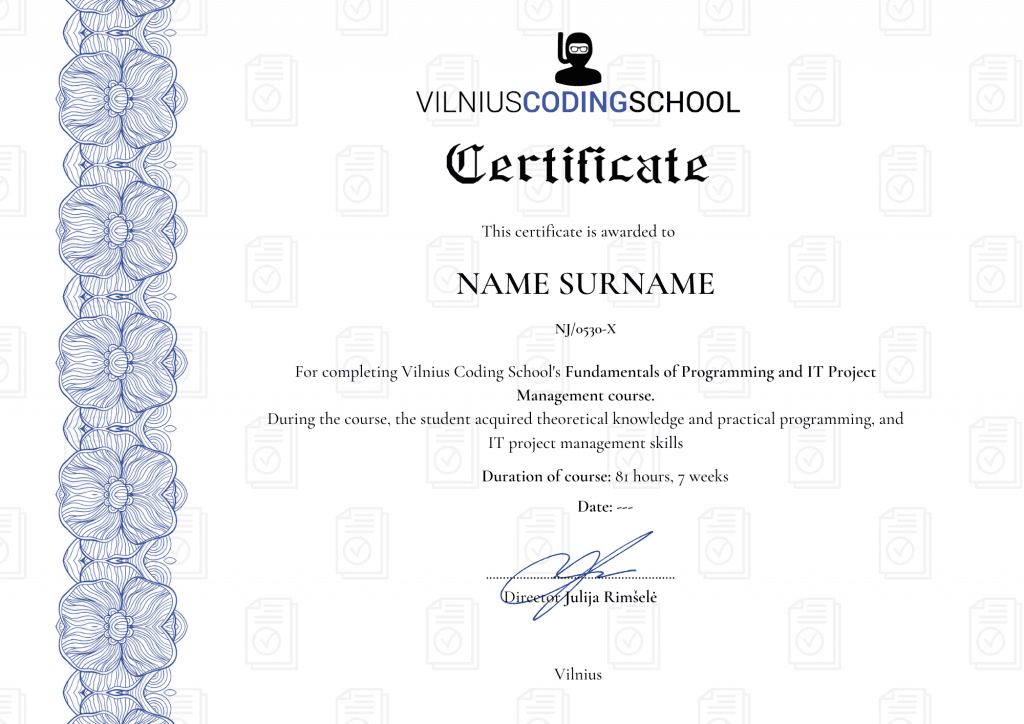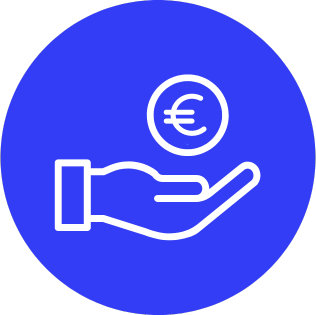FULLY FUNDED FOR WORKING PEOPLE. These trainings are balanced for working people who want to understand and learn how WEB sites are created.
What after training?
After these trainings, students are invited to continue participating in the school's mentoring program free of charge: for a whole month, if questions arise, they can both contact the school's lecturer and use the school's classrooms for independent study.
For our students who want to start a career in the IT field, the Career Center will help them search for an internship or job, provide all the necessary information about job interviews, help them prepare a strong and attractive CV and LinkedIn profile, which will distinguish you from other candidates during the selection process. We constantly share job and internship offers and advise on all issues related to employment. You will not be alone during your job search, our professional team of consultants and mentors will provide comprehensive assistance to achieve your goal of successfully starting a career in the IT field.
Vilnius Coding School cooperates with more than 250 companies - partners that can provide career opportunities for graduates of our school. Even 85 percent everyone who has finished school and applied for a job is successfully employed.
Training program
- Work environment.
- What is HTML and what is its role in the WEB?
– Syntax of tags (elements and their attributes).
– The structure of the web page (doctype, html, head, body, … tags).
– Rules for code neatness. Comments.
- Headlines.
- Paragraphs. Format text using bold, italic, underline, and other formatting techniques.
– References (absolute and relative).
- Pictures. Inserting them, adjusting their size, describing the alternative text, making a clickable image.
- Tables. Creating a table. Table borders, rows, cells, header cells, cell merging.
- Lists. Unordered and ordered lists. List within a list / multi-level lists.
- Forms. Purpose, description, fields of the forms. Text, numbers, files and other types of fields, their attributes, use.
– Useful text editor plugins.
– Other HTML elements.
– Extracting fonts, colors, images and styling from designs with Figma/Adobe XD.
- UI/UX
- What is CSS?
– Syntax (selectors, declarations, parameters and values).
– Code tidiness and commenting.
– Selectors and their types.
- Where and how is the CSS code written?
- Browser developer tool.
– Colors and backgrounds, managing images and other html elements using css.
– Text formatting. Fonts, text sizes, styles, weights and other formatting issues.
– CSS box pattern (content, padding, border, margin).
– Behavior of elements in a row (display).
– Positioning of elements (position).
– Responsive web page layout (layout). Flexbox/CSS grid.
– Accessibility (navigation using the keyboard, colors and contrast, adapted to people who do not distinguish or poorly distinguish colors)
– Other CSS parameters. CSS preprocessors.
- What is a CSS Framework? What are the options (Bootstrap / Tailwind etc.) and how can they be useful?
- How to prepare the project to use the CSS framework?
- What is JavaScript?
– Variables, functions.
– Check conditions (if, switch).
– Loops (for, while, do while, for…in, for…of, forEach).
– Arrays, standard ES6+ functions (filter, map, find, etc.).
– DOM manipulation.
- Introduction. What is testing? Testing Objectives. What and when we test.
– Types of testing. Which ones do we use when? Advantages of different types.
– Component testing (Unit testing).
– Integration testing (Integration testing).
– End-to-end (UI / Dom) testing.
– Regression testing.
– Testing by Mock'ing functionalities.
– Preparing the environment for testing. Practical examples.
- Introduction to ReactJS: what it is, what are the advantages of using it, the principle of operation, environment preparation.
– Introduction to JSX (usage, React, prototypes, collection types).
– React states. State management (state). Principles of immutability.
– React lifecycle methods.
– React interactive and static components (stateful / stateless). Pros.
– React class components and functional components.
- React hooks
- Introduction to TypeScript: what it is, what are the advantages of using it, the principle of operation, environment preparation.
- What is the benefit of choosing TypeScript? Comparison of dynamic and static type languages.
– Object-oriented programming principles and components available in TypeScript
(Abstract classes, Interface...).
– Descriptions of variable types.
– Structural types, descriptions of the "form" of the data structure (Structural types, index signatures).
– Practical examples.
Refinement and presentation of the final work Project improvement and presentation of the final project.
1. Communication skills
- Active listening
- Effective communication
- Dealing with difficult customers
- Creating a connection
2. Problem solving strategies
- Problem analysis and diagnostics
- Determination of solutions
- Troubleshooting methods
- Root cause analysis of the problem
- Latest problem solving technologies
- How to get feedback from managers
- Professional development
3. Time management and organization
- Prioritization of tasks
- Workload management
- Delegation and collaboration
4. Emotional intelligence
- Understanding and managing emotions
- Empathy and compassion
- Conflict resolution
- Stress management
5. How to learn more and faster and less
to forget
- 5 minute brain exercise
- Clear your "mental fog" with these 5
delicious brain foods - Learn a powerful memory technique to
you would never miss a meeting
Vilnius coding School CERTIFICATE
strong evidence that you are ready career ITEM!

Official certificate approved by the Education and Science Register
Recognized by the strongest Lithuanian and international companies
It proves that you have studied with the best specialists in your field
Reliable proof of acquired skills
Certificate issued by a company developing transparent activities in Lithuania
This certificate confirms that you attended at least 95% of the course lectures in real time with the lecturer, completed and defended the final thesis











